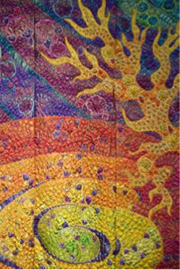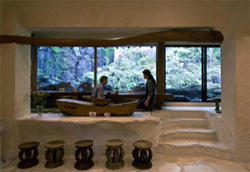Home > Highlighting JAPAN > Highlighting Japan OCTOBER 2011 > Itchiku Kubota Art Museum
Highlighting JAPAN
THE NATION'S MUSEUMS

Caption: Kimonos from the Universe section of Itchiku Kubota's Symphony of Light series are displayed on a raised stage under natural light in the pyramid-shaped main building of the Itchiku Kubota Art Museum.
Credit: ROB GILHOOLY
Itchiku Kubota Art Museum
Julian Ryall continues his tour of notable Japanese museums with a visit to Itchiku Kubota Art Museum, established by world-renowned textile-dyeing artist Itchiku Kubota, in Fuji-Kawaguchiko, Yamanashi Prefecture.

A detail from Uzu, a kimono in Itchiku Kubota's Symphony of Light series
Credit: ROB GILHOOLY
And so it does.
Opened in 1994, the museum overlooks Lake Kawaguchiko and across to the flanks of Mount Fuji. It regularly displays forty-some kimonos that textile-dyeing artist Itchiku Kubota (1917–2003) created using the tsujigahana (literally, "way-side flower") technique, so named originally for the blossoms that were typically used in their designs.
The tsujigahana technique of detailed shibori (tie-dyeing) and embroidery dates from the early fourteenth-century and had been virtually forgotten before Kubota set himself the task of replicating it. In doing so he created his own unique style and set about an ambitious project to make eighty kimonos in a series he would name Symphony of Light. Each kimono would take a minimum of one year to craft, with the work being continued today by his family and apprentices.
"Itchiku Kubota saw a piece of tsujigahana work in another museum and wanted to make such a piece himself," explains Fumihiko Takamura, a spokesman for the museum. "Having done that, he wanted to make a museum to protect this important part of Japan's cultural heritage and history.
"He traveled all around Mount Fuji to find the perfect location for the museum, because the mountain had always inspired him; he finally chose this place because of its views," he says.
The Main Building is a pyramid-shaped structure supported by sixteen vast trunks of the hiba tree that are more than 1,000 years old. Light filters in through the glass tip of the pyramid, illuminating the kimonos exhibited on a raised stage in the middle of the building in addition to those arrayed along the walls. None of the kimonos are exhibited behind glass—one of Kubota's stipulations—so visitors can really "feel" the art.
Kubota served in the Japanese military during World War II and was interned in Siberia for three years at the end of the conflict, but drew upon that time for some of his most breathtaking works.

Itchiku Kubota's private room now serves as a tearoom.
Credit: ROB GILHOOLY
Of them all, the kimono that depicts a Siberian sun setting—a gorgeous blend of oranges and golds—is a personal favorite. Up close, each individual strand of material sparkles in the light.
Along one wall, eight kimonos tell the tale of late winter: light snowfall becomes a blizzard before clearing to reveal a frozen blue landscape.
Kubota's private room to the rear of the building now serves as a tearoom where visitors can enjoy a cup of green tea as they admire the view of a waterfall tumbling into a pond, both of which the artist designed. The statues and carvings displayed here come from Africa and Asia.
Such exotic objects can also be found in the New Wing of the museum, which was added in 1997 and is quite different from the rest of the complex. According to Takamura, Kubota was an admirer of Antoni Gaudi and requested that the new wing reflect some of the Spanish architect's inspirations. Kubota also traveled extensively in Okinawa and was fascinated with Ryukyu limestone, which is formed from fossilized coral reefs. This influence too was incorporated in the building design, an impressive structure of coral with angled columns that looks out onto a performance area for musicians. The New Wing also houses a special gallery for events, currently displaying kabuki costumes, an open-air café and the museum shop.
| Access and Admission | |
| Address: | 2255 Kawaguchi, Fuji-Kawaguchiko-machi, Minamitsuru-gun, Yamanashi Prefecture 401-0304. |
| Tel: | +81 (0)555-76-8811 |
| E-mail: | info@itchiku-museum.com |
| Website: | www.itchiku-museum.com |
| Holidays: | Closed Wednesdays (except for holidays) from December to March, and from December 26–28. |
| Admission: | ¥1,300 for adults, ¥900 for college and high school students, and ¥400 for children. |
© 2009 Cabinet Office, Government of Japan






